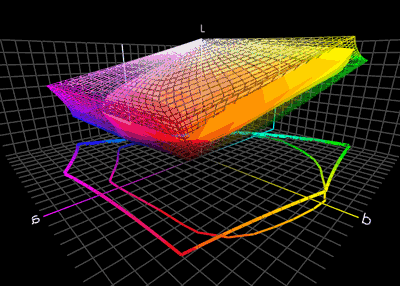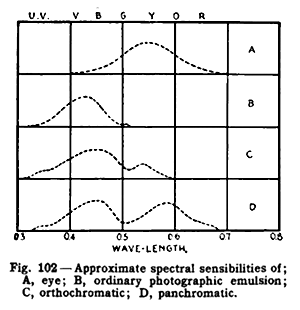|
CIEXYZ
In 1931, the International Commission on Illumination (CIE) published the CIE 1931 color spaces which define the relationship between the visible spectrum and human color vision. The CIE color spaces are mathematical models that comprise a "standard observer", which is a static idealization of the color vision of a normal human. A useful application of the CIEXYZ colorspace is that a mixture of two colors in some proportion lies on the straight line between those two colors. One disadvantage is that it is not perceptually uniform. This disadvantage is remedied in subsequent color models such as CIELUV and CIELAB, but these and modern color models still use the CIE 1931 color spaces as a foundation. The CIE (from the French name " Commission Internationale de l'éclairage" - International Commission on Illumination) developed and maintains many of the standards in use today relating to colorimetry. The CIE color spaces were created using data from a series of experiments, where ... [...More Info...] [...Related Items...] OR: [Wikipedia] [Google] [Baidu] |
Color Model
In color science, a color model is an abstract mathematical model describing the way colors can be represented as tuples of numbers, typically as three or four values or color components. When this model is associated with a precise description of how the components are to be interpreted (viewing conditions, etc.), taking account of visual perception, the resulting set of colors is called "color space." This article describes ways in which human color vision can be modeled, and discusses some of the models in common use. Tristimulus color space One can picture this space as a region in three-dimensional Euclidean space if one identifies the ''x'', ''y'', and ''z'' axes with the stimuli for the long-wavelength (''L''), medium-wavelength (''M''), and short-wavelength (''S'') Cone cell, light receptors. This is called the LMS color space. The origin, (''S'',''M'',''L'') = (0,0,0), corresponds to black. White has no definite position in this diagram; rather it is defined accordi ... [...More Info...] [...Related Items...] OR: [Wikipedia] [Google] [Baidu] |
Standard Observer
In 1931, the International Commission on Illumination (CIE) published the CIE 1931 color spaces which define the relationship between the visible spectrum and human color vision. The CIE color spaces are mathematical models that comprise a "standard observer", which is a static idealization of the color vision of a normal human. A useful application of the CIEXYZ colorspace is that a mixture of two colors in some proportion lies on the straight line between those two colors. One disadvantage is that it is not perceptually uniform. This disadvantage is remedied in subsequent color models such as CIELUV and CIELAB, but these and modern color models still use the CIE 1931 color spaces as a foundation. The CIE (from the French name " Commission Internationale de l'éclairage" - International Commission on Illumination) developed and maintains many of the standards in use today relating to colorimetry. The CIE color spaces were created using data from a series of experiments, where hu ... [...More Info...] [...Related Items...] OR: [Wikipedia] [Google] [Baidu] |
CIELAB
The CIELAB color space, also referred to as ''L*a*b*'', is a color space defined by the International Commission on Illumination (abbreviated CIE) in 1976. It expresses color as three values: ''L*'' for perceptual lightness and ''a*'' and ''b*'' for the four Unique hues, unique colors of human vision: red, green, blue and yellow. CIELAB was intended as a perceptually uniform space, where a given numerical change corresponds to a similar perceived change in color. While the LAB space is not truly perceptually uniform, it nevertheless is useful in industry for detecting small differences in color. Like the CIE 1931 color space, CIEXYZ space it derives from, CIELAB color space is a device-independent, "standard observer" model. The colors it defines are not relative to any particular device such as a computer monitor or a printer, but instead relate to the CIE 1931 color space#CIE standard observer, CIE standard observer which is an averaging of the results of color matching expe ... [...More Info...] [...Related Items...] OR: [Wikipedia] [Google] [Baidu] |
CIELUV
In colorimetry, the CIE 1976 ''L''*, ''u''*, ''v''* color space, commonly known by its abbreviation CIELUV, is a color space adopted by the International Commission on Illumination (CIE) in 1976, as a simple-to-compute transformation of the 1931 CIE XYZ color space, but which attempted perceptual uniformity. It is extensively used for applications such as computer graphics which deal with colored lights. Although additive mixtures of different colored lights will fall on a line in CIELUV's uniform chromaticity diagram (called the ''CIE 1976 UCS''), such additive mixtures will not, contrary to popular belief, fall along a line in the CIELUV color space unless the mixtures are constant in lightness. Historical background CIELUV is an Adams chromatic valence color space and is an update of the CIE 1964 (''U''*, ''V''*, ''W''*) color space (CIEUVW). The differences include a slightly modified lightness scale and a modified uniform chromaticity scale, in which one of the coordina ... [...More Info...] [...Related Items...] OR: [Wikipedia] [Google] [Baidu] |
LMS Color Space
LMS (long, medium, short), is a color space which represents the response of the three types of Cone cell, cones of the human eye, named for their responsivity (sensitivity) peaks at long, medium, and short wavelengths. The numerical range is generally not specified, except that the lower end is generally bounded by zero. It is common to use the LMS color space when performing chromatic adaptation (estimating the appearance of a sample under a different illuminant). It is also useful in the study of color blindness, when one or more cone types are defective. Definition The cone response functions \bar(\lambda), \bar(\lambda),\bar(\lambda) are the color matching functions (CMFs) for the LMS color space. The chromaticity coordinates (L, M, S) for a spectral distribution J(\lambda) are defined as: : L = \int^\infty_0 J(\lambda)\bar(\lambda)d\lambda : M = \int^\infty_0 J(\lambda)\bar(\lambda)d\lambda : S = \int^\infty_0 J(\lambda)\bar(\lambda)d\lambda The cone response function ... [...More Info...] [...Related Items...] OR: [Wikipedia] [Google] [Baidu] |
Color Space
A color space is a specific organization of colors. In combination with color profiling supported by various physical devices, it supports reproducible representations of colorwhether such representation entails an analog or a digital representation. A color space may be arbitrary, i.e. with physically realized colors assigned to a set of physical color swatches with corresponding assigned color names (including discrete numbers infor examplethe Pantone collection), or structured with mathematical rigor (as with the NCS System, Adobe RGB and sRGB). A "color space" is a useful conceptual tool for understanding the color capabilities of a particular device or digital file. When trying to reproduce color on another device, color spaces can show whether shadow/highlight detail and color saturation can be retained, and by how much either will be compromised. A "color model" is an abstract mathematical model describing the way colors can be represented as tuples of numbers (e. ... [...More Info...] [...Related Items...] OR: [Wikipedia] [Google] [Baidu] |
Color Management
Color management is the process of ensuring consistent and accurate colors across various devices, such as monitors, printers, and cameras. It involves the use of color profiles, which are standardized descriptions of how colors should be displayed or reproduced. Color management is necessary because different devices have different color capabilities and characteristics. For example, a monitor may display colors differently than a printer can reproduce them. Without color management, the same image may appear differently on different devices, leading to inconsistencies and inaccuracies. To achieve color management, a color profile is created for each device involved in the color workflow. This profile describes the device's color capabilities and characteristics, such as its color gamut (range of colors it can display or reproduce) and color temperature. These profiles are then used to translate colors between devices, ensuring consistent and accurate color reproduction. Col ... [...More Info...] [...Related Items...] OR: [Wikipedia] [Google] [Baidu] |
Metamerism (color)
In colorimetry, metamerism is a perceived matching of colors with different (nonmatching) spectral power distributions. Colors that match this way are called metamers. A spectral power distribution describes the proportion of total light given off (emitted, transmitted, or reflected) by a color sample at each visible wavelength; it defines the complete information about the light coming from the sample. However, the human eye contains only three color receptors (three types of cone cells), which means that all colors are reduced to three sensory quantities, called the tristimulus values. Metamerism occurs because each type of cone responds to the cumulative energy from a broad range of wavelengths, so that different combinations of light across all wavelengths can produce an equivalent receptor response and the same tristimulus values or color sensation. In color science, the set of sensory spectral sensitivity curves is numerically represented by color matching functions. Sou ... [...More Info...] [...Related Items...] OR: [Wikipedia] [Google] [Baidu] |
Hermann Grassmann
Hermann Günther Grassmann (, ; 15 April 1809 – 26 September 1877) was a German polymath known in his day as a linguist and now also as a mathematician. He was also a physicist, general scholar, and publisher. His mathematical work was little noted until he was in his sixties. His work preceded and exceeded the concept which is now known as a vector space. He introduced the Grassmannian, the space which parameterizes all ''k''-dimensional linear subspaces of an ''n''-dimensional vector space ''V''. In linguistics he helped free language history and structure from each other. Biography Hermann Grassmann was the third of 12 children of Justus Günter Grassmann, an ordained minister who taught mathematics and physics at the Stettin Gymnasium, where Hermann was educated. Grassmann was an undistinguished student until he obtained a high mark on the examinations for admission to Prussian universities. Beginning in 1827, he studied theology at the University of Berlin, also ta ... [...More Info...] [...Related Items...] OR: [Wikipedia] [Google] [Baidu] |
Additive Color
Additive color or additive mixing is a property of a color model that predicts the appearance of colors made by coincident component lights, i.e. the perceived color can be predicted by summing the numeric representations of the component colors. Modern formulations of Grassmann's laws describe the additivity in the color perception of light mixtures in terms of algebraic equations. Additive color predicts perception and not any sort of change in the photons of light themselves. These predictions are only applicable in the limited scope of color matching experiments where viewers match small patches of uniform color isolated against a gray or black background. Additive color models are applied in the design and testing of electronic displays that are used to render realistic images containing diverse sets of color using phosphors that emit light of a limited set of primary colors. Examination with a sufficiently powerful magnifying lens will reveal that each pixel in CRT, ... [...More Info...] [...Related Items...] OR: [Wikipedia] [Google] [Baidu] |
Spectral Sensitivity
Spectral sensitivity is the relative efficiency of detection, of light or other signal, as a function of the frequency or wavelength of the signal. In visual neuroscience, spectral sensitivity is used to describe the different characteristics of the photopigments in the rod cells and cone cells in the retina of the eye. It is known that the rod cells are more suited to scotopic vision and cone cells to photopic vision, and that they differ in their sensitivity to different wavelengths of light. It has been established that the maximum spectral sensitivity of the human eye under daylight conditions is at a wavelength of 555 nm, while at night the peak shifts to 507 nm. In photography, film and sensors are often described in terms of their spectral sensitivity, to supplement their characteristic curves that describe their responsivity. A database of camera spectral sensitivity is created and its space analyzed. For X-ray films, the spectral sensitivity is chosen t ... [...More Info...] [...Related Items...] OR: [Wikipedia] [Google] [Baidu] |





